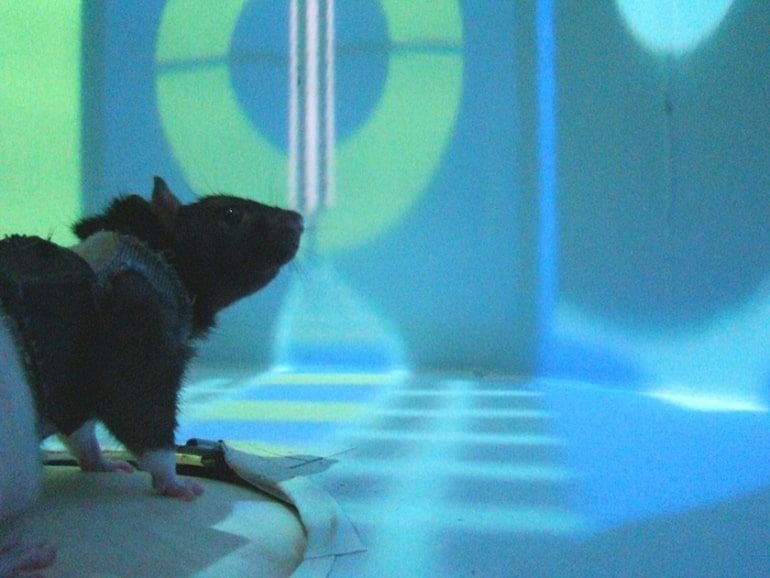Summary: Studying rats in a virtual reality maze, researchers discover certain hippocampal neurons play a vital role in a specific mechanism of navigation.
Source: UCLA
Scientists have long understood that the region of the brain called the hippocampus is important for memory, learning and navigation.
Now, scientists in a UCLA lab led by neurophysicist Mayank Mehta are gaining a deeper understanding of how the hippocampus works on a circuit level — that is, functions involving networks of millions of neurons. That knowledge could be an important step toward the development of treatments for neurological disorders such as Alzheimer’s disease, schizophrenia and epilepsy, all of which are related to dysfunction in the hippocampus.
In their latest study, published in the journal Nature, the scientists studied rats in a virtual reality maze. While observing the activities of large numbers of individual neurons in each animal’s hippocampus, the scientists discovered responses in those neurons that revealed a specific mechanism for navigation.
“The hippocampus is one of the first regions to be affected in memory-based diseases like Alzheimer’s,” said the study’s lead author, Jason Moore, a former UCLA postdoctoral scholar who is now at New York University. “So it is crucial to understand its functionality, flexibility and limits.”
The study could help explain why people with damage to the hippocampus struggle not just with so-called spatial tasks, like finding their way home or locating a lost set of keys, but also with memory tasks, such as recalling what they had for lunch or whether they took their daily medication.
The experiment used a type of virtual reality system that was developed in Mehta’s lab. The technology is intended to keep the animals comfortable and avoid causing dizziness and other symptoms that other VR systems can trigger.
For the study, rats were placed on a small treadmill inside a box with images of a maze projected onto the container’s walls. The rats were encouraged to run through the maze to find their reward, a drop of sugar water. In order to make it to the reward, rats needed to discern where they were in relation to the virtual objects around them, where they needed to go to receive their rewards and how far away the destination was.
Several animals were tested over many sessions, enabling the researchers to observe how the neurons’ responses changed as the rats learned to navigate the maze.
The scientists observed that hippocampal neurons encoded multiple aspects of the animal’s location — where it is in space, the angle of its body relative to its reward and how far it has moved along its path — a phenomenon called “multiplexing.”
That finding is significant because it had been widely thought that neurons in the hippocampus code only for position.
“We found that in the virtual maze, the neurons carry very little information about the rat’s position,” said Mehta, a UCLA professor of neurology, neurobiology and physics. “Instead, most neurons encode for other aspects of navigation, such as distance traveled and which direction the body is heading.”
The scientists also observed that as the rats gained experience in the maze, their neurons “remembered” the maze even more reliably and accurately.
Research in Mehta’s lab and elsewhere over the past 25 years has shown that such changes in neurons’ activity — or neuroplasticity — occur via a process neuroscientists call Hebbian learning. That process is mediated by a neurochemical called NMDA, which is a common target for drugs used to treat neurological disorders.

Mehta said the neuroplasticity scientists observed in the rats is likely due to Hebbian learning across billions of synapses. That conclusion was further proven when the researchers injected the animals with substances to inhibit their NMDA, which impaired their performance in the maze.
“Remarkably, neuroplasticity was far greater in the virtual reality environment than in simpler, real-world mazes,” Mehta said. “Further, this boosted neuroplasticity was related to performance.”
Also contributing to the research were co-authors Jesse Cushman, Lavanya Acharya and Brianna Popeny, all of UCLA, as well as several UCLA undergraduate students.
In future studies, Mehta and his colleagues will conduct similar research on rats and on humans with memory impairment, to test wither virtual reality can be used for early diagnosis and to evaluate the effectiveness of medications.
About this neurotech and learning research news
Author: Lisa Garibay
Source: UCLA
Contact: Lisa Garibay – UCLA
Image: The image is credited to Mehta Lab/UCLA
Original Research: Closed access.
“Linking hippocampal multiplexed tuning, Hebbian plasticity and navigation” by Jason Moore et al. Nature
Abstract
Linking hippocampal multiplexed tuning, Hebbian plasticity and navigation
Three major pillars of hippocampal function are spatial navigation, Hebbian synaptic plasticity and spatial selectivity. The hippocampus is also implicated in episodic memory, but the precise link between these four functions is missing. Here we report the multiplexed selectivity of dorsal CA1 neurons while rats performed a virtual navigation task using only distal visual cues, similar to the standard water maze test of spatial memory.
Neural responses primarily encoded path distance from the start point and the head angle of rats, with a weak allocentric spatial component similar to that in primates but substantially weaker than in rodents in the real world. Often, the same cells multiplexed and encoded path distance, angle and allocentric position in a sequence, thus encoding a journey-specific episode. The strength of neural activity and tuning strongly correlated with performance, with a temporal relationship indicating neural responses influencing behaviour and vice versa.
Consistent with computational models of associative and causal Hebbian learning, neural responses showed increasing clustering and became better predictors of behaviourally relevant variables, with the average neurometric curves exceeding and converging to psychometric curves.
Thus, hippocampal neurons multiplex and exhibit highly plastic, task- and experience-dependent tuning to path-centric and allocentric variables to form episodic sequences supporting navigation.






